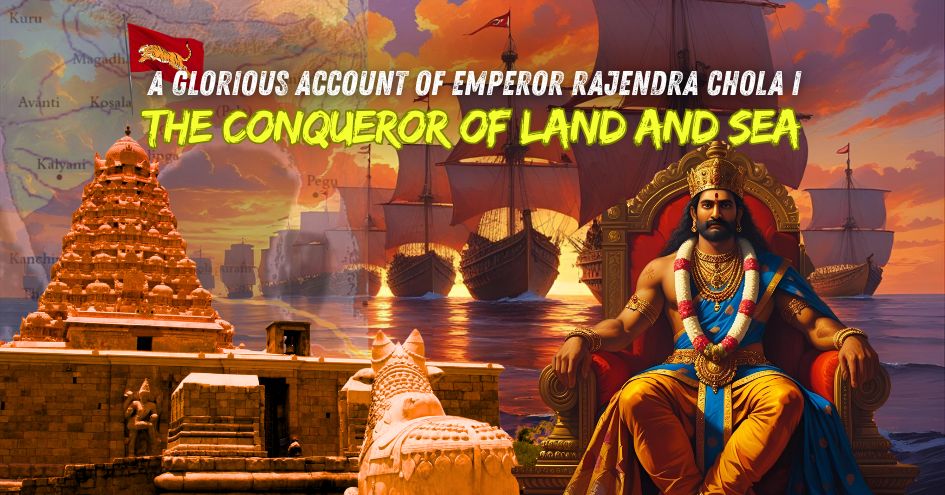
In the annals of Indian history, few monarchs have ruled with the brilliance, vision, and valour that Rajendra Chola I did. Crowned as the Gangaikonda Chola—the one who brought the Ganges to the south—he was not merely the son of the legendary Rajaraja Chola I, but a titan in his own right. If his father laid the foundation of Chola supremacy, Rajendra Chola expanded it to legendary heights, turning the Chola Empire into one of the greatest maritime powers the world had ever seen.
Born in the late 10th century CE, Rajendra was trained as a warrior, administrator, and statesman from an early age. As co-regent under his father, he already commanded armies, crushed rebellions, and governed vast provinces. His military brilliance was evident even before he ascended the throne in 1014 CE, after Rajaraja’s passing. Rajendra Chola’s most audacious land campaign was the march to the Ganges. With unmatched military logistics and precision, his forces surged through the Deccan, defeating the Western Chalukyas, the Kalachuris, and Palas of Bengal. When his mighty army reached the banks of the Ganga, he had water from the holy river brought back in golden vessels. This campaign earned him the glorious title:
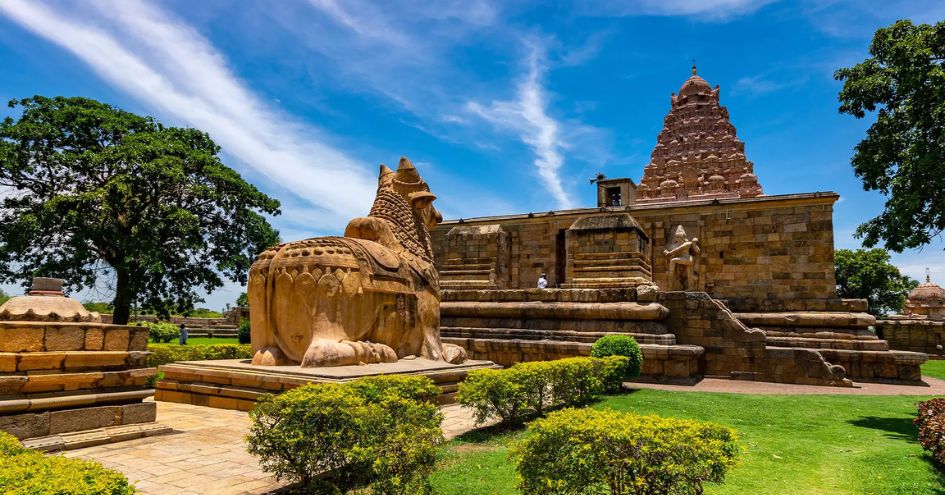
“Gangaikonda Cholan” – The Chola who took the Ganga.”
After his triumphant northern campaign up to the Ganga River (circa 1023 CE), Rajendra Chola returned with water from the sacred river, brought in golden vessels as a ritual offering. To commemorate this extraordinary feat, he founded a new capital named Gangaikonda Cholapuram. This new city was designed to reflect the glory of his empire, from the Vindhyas to Sumatra. It was a well-planned city with palaces, granaries, assembly halls, and temples. A hub of international diplomacy, naval command, and merchant guilds. It was linked with port cities like Nagapattinam and Poompuhar, enabling maritime trade with China, Arabia, and Southeast Asia. Rajendra ensured the city reflected imperial order, Shaivite devotion, and cosmopolitan pride.
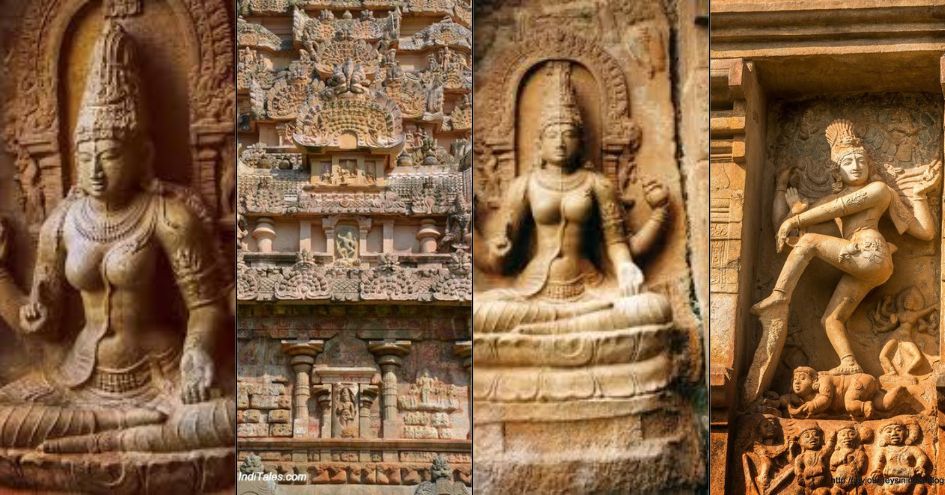
At the heart of the city lies the Brihadisvara Temple (also known as Gangaikonda Cholapuram Temple), a UNESCO World Heritage site, part of the “Great Living Chola Temples” group. Built in Dravidian style, it mirrors the Brihadisvara Temple of Thanjavur but with more elegance and intricate detail. The Vimana (temple tower) stands at 182 feet—slightly shorter than Thanjavur’s—but broader and more elaborately sculpted, giving it a majestic visual grandeur. The Shiva Lingam inside is one of the largest in India, symbolising the cosmic power of the emperor's patron deity. The bronze work, pillared mandapas, dvarapalas (gatekeepers), and intricate friezes showcase Chola excellence in art, metallurgy, and sculpture. The temple tank is said to have been sanctified with Ganga water Rajendra brought back.
This temple not only served religious purposes but was also a centre of education, culture, and governance. While much of the city is now lost to time, inscriptions and archaeological remains suggest that Gangaikonda Cholapuram was a well-planned city in those times.
Rajendra Chola’s Naval Conquest of Southeast Asia: The First Great Overseas Campaign by an Indian Emperor
By the early 11th century, Rajendra Chola I had already achieved what few Indian kings before him had—military dominance across peninsular India, including the Chalukyas, Pandyas, Gangas, and Pala dynasty of Bengal. But for Rajendra, the empire did not end at the coastline. But Rajendra was not content with land conquests. He set his sights on the seas. In 1025 CE, he launched an audacious naval expedition—arguably the first overseas campaign by any Indian emperor—targeting the Srivijaya Empire (modern-day Indonesia, Malaysia, and Thailand). His vision extended beyond—across the Bay of Bengal to the golden lands of Southeast Asia. At that time, the Srivijaya Empire, headquartered at Palembang in Sumatra, was the dominant naval and trade power in the region, commanding the vital Straits of Malacca. They controlled maritime routes between India and China, extracting tribute from merchants and guarding the sea lanes with near impunity.
But that changed in 1025 CE, when Rajendra Chola launched the boldest Indian naval operation in history.
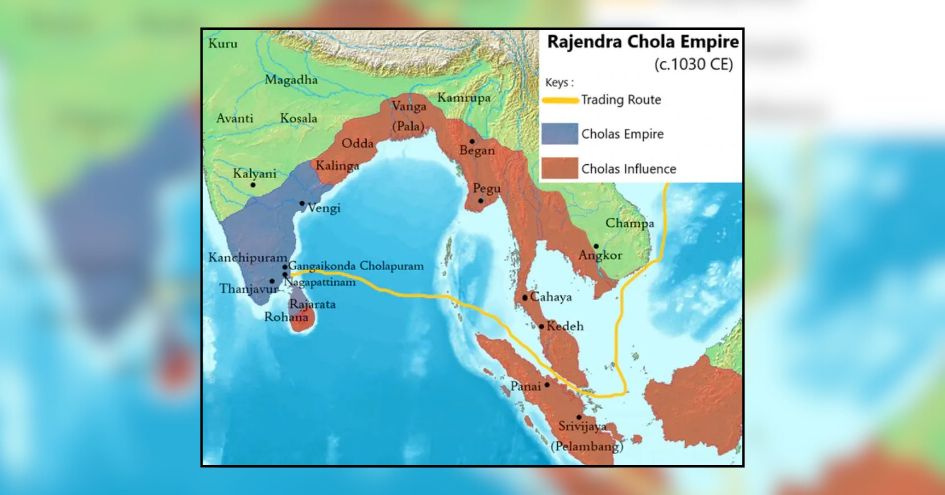
A Blue-Water Navy Unleashed
Rajendra Chola’s fleet was not a coastal flotilla. It was a true blue-water navy—well-armed, expertly commanded, and logistically supported for long-range expeditions. Sailing from ports like Nagapattinam and Poompuhar, the Chola ships cut across the Bay of Bengal like arrows from Shiva’s bow. Their targets were precise and ambitious. The Chola Navy struck with speed and ferocity, taking Srivijaya by complete surprise. Kedah(modern Malaya) a key trade port on the western Malay Peninsula—was raided and captured.
Tambralinga (Southern Thailand) a Srivijaya vassal—was subdued and brought under Chola authority.
Ligor (modern-day Nakhon Si Thammarat) another key regional ally of Srivijaya—was stormed and razed.
Srivijaya / Palembang (Sumatra, Indonesia) the imperial capital—attacked and sacked, its ruler Sangrama Vijayottungavarman captured or defeated. These conquests, mentioned in Rajendra Chola’s inscriptions at the Brihadisvara Temple and Tanjore, list the defeated as "Kadaram, Talaittakkolam, Mayirudingam, Ilamuridesam, Manakkavaram..."—a clear record of cities across Malaysia, Thailand, and Indonesia.
The Significance of the Campaign
Rajendra demonstrated that Indian naval power could project force over 2,000 kilometres away, defeating a dominant maritime power on its shores. By smashing Srivijaya’s hold over the Straits of Malacca, Rajendra re-routed Indian trade directly, protecting Tamil merchant guilds like the Ayyavole 500 and Manigramam. It gave Chola merchants safe access to China, bypassing intermediaries. No other Indian ruler before (or arguably after, until modern times) had launched such a wide-ranging, successful overseas expedition. China's Song dynasty, impressed by the campaign, acknowledged the Cholas as a powerful equal in the eastern seas. The Andaman and Nicobar Islands lie almost directly along the maritime route from the Tamil coast (like Nagapattinam, a major Chola port) to Southeast Asia.
During Rajendra Chola’s legendary naval expedition in 1025 CE against the Srivijaya Empire (in present-day Indonesia and Malaysia), the islands would have been a natural logistical halting point for resupply, repairs, or navigation. Historical evidence strongly suggests that the Cholas had established a naval presence in the Andaman and Nicobar Islands, although it may not have been a full-fledged naval "base" in the modern sense. Instead, it likely served as a strategic maritime outpost, supply point, and staging ground for their powerful overseas expeditions—especially during the reign of Rajendra Chola I.
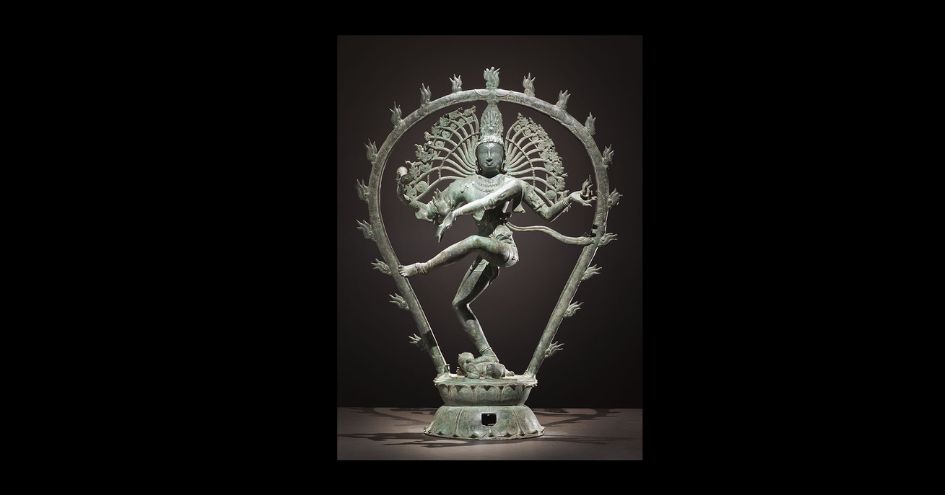
Cultural Influence
The Tamil language and Shaivite culture spread alongside trade. Tamil inscriptions and temple architecture later appear across Southeast Asia, reflecting the enduring influence of the Chola presence.
The campaign was not aimed at annexation but dominance, deterrence, and control over trade. After establishing suzerainty and humiliating Srivijaya, the Cholas likely withdrew, content with tributary arrangements and commercial supremacy. It set a precedent that India was not a landlocked civilisation. It had kings who ruled oceans, whose diplomacy rode waves, and whose warships carried thunder beyond the subcontinent.
Administration and Legacy
Rajendra was not merely a conqueror. He was a visionary ruler, builder, and patron of art and learning:
He built Gangaikonda Cholapuram, an architectural marvel rivalling Thanjavur, and its Brihadisvara Temple, adorned with intricate sculptures and grandeur. He strengthened naval trade routes, connecting India with China, Southeast Asia, and Arabia. He fostered Tamil culture, literature, and Shaivism, making the Chola court a centre of international diplomacy and culture. His epigraphs, engraved in Tamil and Sanskrit across India and abroad, reflect a deep commitment to governance, dharma, and prosperity.
“Where the Ganga flows, and where the seas roar—there echoes the name of Rajendra Chola.”
His empire stretched from the banks of the Ganges to the shores of Java, from the Arabian Sea to the South China Sea. He wasn’t merely a king of a region—he was an emperor of the Indian Ocean realm. Naval historians worldwide study this campaign as one of the earliest and most successful expeditionary naval operations in pre-modern history. It showcases the maritime genius of the Cholas, long before European colonisers imagined oceanic empires. The legacy of Rajendra Chola I is not just in temples—but in waves, ports, scripts, and memories across Southeast Asia. Historians call him the "Napoleon of South India", but that title hardly does justice. Unlike Napoleon, Rajendra’s conquests endured for generations, and his reign was marked not by ruin, but by prosperity, culture, and unity.
Centuries have passed, yet the memory of Rajendra Chola I blazes bright. Rajendra Chola didn’t just conquer land—he rewrote the maritime history of India.
 Wing Commander BS Sudarshan is a former Indian Air Force pilot with over 12,000 flying hours. He participated in Operation Pawan and Operation Cactus before he transitioned to civil aviation. A passionate writer, he has authored six books, including "Hasiru Hampe", appreciated by S L Bhyrappa, and the latest "Evergreen Hampi". He is a regular contributor to the Verandah Club.
Wing Commander BS Sudarshan is a former Indian Air Force pilot with over 12,000 flying hours. He participated in Operation Pawan and Operation Cactus before he transitioned to civil aviation. A passionate writer, he has authored six books, including "Hasiru Hampe", appreciated by S L Bhyrappa, and the latest "Evergreen Hampi". He is a regular contributor to the Verandah Club.
NEXT ARTICLE
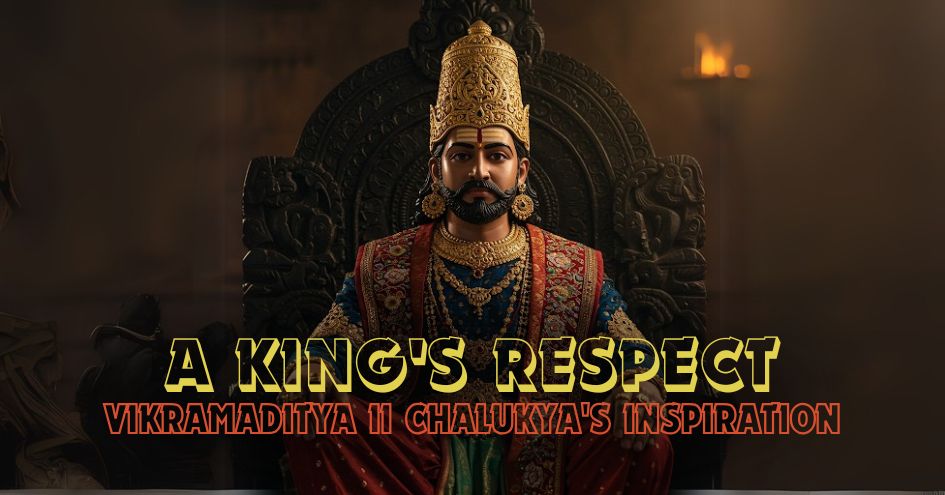
Indian History is rife with conflict between kings for power, territory and regional supremacy. We have seen instances where kings have made it a poin...
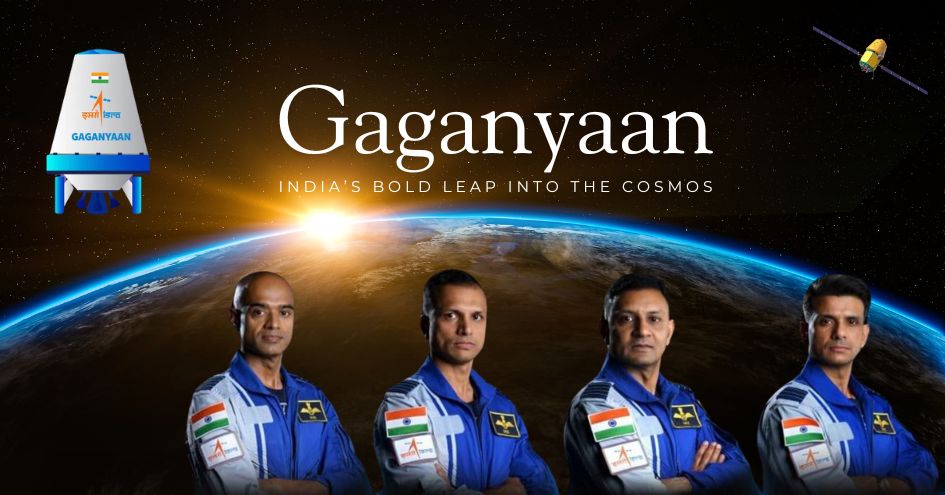
"Saare Jahaan Se Accha, Hindustan Hamara!"These immortal words, spoken by Squadron Leader Rakesh Sharma from the vast expanse of space in 1984, When t...
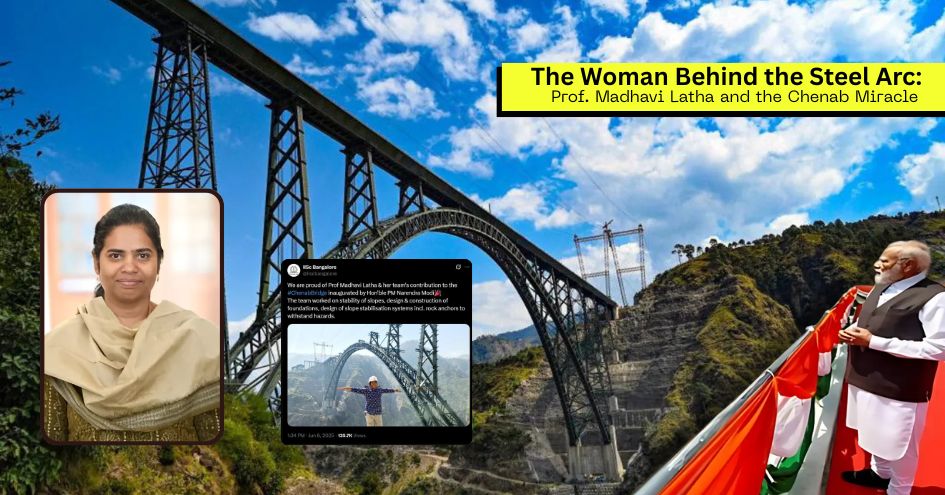
High in the rugged, unforgiving terrain of Jammu and Kashmir’s Reasi district, where the Chenab River slices through deep gorges and the Himalayas loo...